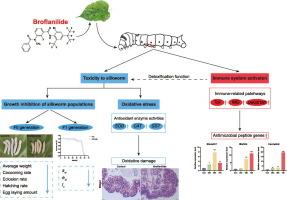The silkworm (Bombyx mori) alleviates the toxic effects of the novel meta-diamide insecticide broflanilide by modulating its midgut immune system
IF 4.3
3区 环境科学与生态学
Q2 BIOCHEMISTRY & MOLECULAR BIOLOGY
Comparative Biochemistry and Physiology C-toxicology & Pharmacology
Pub Date : 2025-07-25
DOI:10.1016/j.cbpc.2025.110304
引用次数: 0
Abstract
Due to the development of resistance in pests to the first two generations of noncompetitive antagonists (NCAs), broflanilide, a novel meta-diamide insecticide targeting the γ-aminobutyric acid receptor (GABAR) in pests, has been widely used in many countries. However, the improper use of broflanilide can result in its residue accumulating in agricultural environments, posing a potential threat to the sericulture industry. In this study, we measured biological parameters of silkworms and found that exposure to sublethal doses of broflanilide significantly inhibited the development, silk yield, and reproduction of silkworms. Meanwhile, we also measured the H₂O₂ content, antioxidant enzyme activities, and MDA levels in the midgut of silkworms. The results indicated that sublethal doses of broflanilide induced oxidative stress in the silkworm midgut and caused tissue damage. In addition, we measured the expression levels of immune-related signaling pathway genes in the silkworm midgut using qRT-PCR. The results showed that broflanilide significantly increased the expression levels of genes in the TOLL, immune deficiency (IMD), and JAK/STAT signaling pathways, as well as antimicrobial peptide genes. This suggests that immune regulation in the midgut may help silkworms resist the toxicity of broflanilide. Finally, through age-stage two-sex life table analysis, we found that broflanilide reduced the life table parameters (sxj, exj, and lx) of the F1 generation silkworms. This indicates that broflanilide has transgenerational effects on silkworms. In summary, broflanilide exerts multiple adverse effects on silkworms and their offspring, while silkworms can mitigate the toxicity of broflanilide through immune regulation in the midgut.

家蚕(Bombyx mori)通过调节其中肠免疫系统来减轻新型间二胺杀虫剂溴flanilide的毒性作用
由于害虫对前两代非竞争性拮抗剂(NCAs)的抗性发展,溴flanilide作为一种靶向害虫γ-氨基丁酸受体(GABAR)的新型间二胺类杀虫剂已在许多国家得到广泛应用。然而,溴flanilide的不当使用会导致其残留在农业环境中积累,对蚕桑产业构成潜在威胁。在这项研究中,我们测量了家蚕的生物学参数,发现暴露于亚致死剂量的溴flanilide显著抑制了家蚕的发育、产丝和繁殖。同时,我们还测定了家蚕中肠中H₂O₂含量、抗氧化酶活性和MDA水平。结果表明,亚致死剂量溴flanilide可诱导家蚕中肠氧化应激,造成组织损伤。此外,我们利用qRT-PCR技术检测了家蚕中肠中免疫相关信号通路基因的表达水平。结果表明,溴flanilide显著提高了TOLL、免疫缺陷(IMD)和JAK/STAT信号通路基因以及抗菌肽基因的表达水平。这表明,中肠的免疫调节可能有助于家蚕抵抗溴flanilide的毒性。最后,通过年龄阶段两性生命表分析,我们发现溴氰胺降低了F1代家蚕的生命表参数(sxj、exj和lx)。这表明溴flanilide对家蚕具有跨代效应。综上所述,溴flanilide对家蚕及其后代有多重不良影响,而家蚕可以通过中肠免疫调节来减轻溴flanilide的毒性。
本文章由计算机程序翻译,如有差异,请以英文原文为准。
求助全文
约1分钟内获得全文
求助全文
来源期刊
CiteScore
7.50
自引率
5.10%
发文量
206
审稿时长
30 days
期刊介绍:
Part C: Toxicology and Pharmacology. This journal is concerned with chemical and drug action at different levels of organization, biotransformation of xenobiotics, mechanisms of toxicity, including reactive oxygen species and carcinogenesis, endocrine disruptors, natural products chemistry, and signal transduction with a molecular approach to these fields.

 求助内容:
求助内容: 应助结果提醒方式:
应助结果提醒方式:


